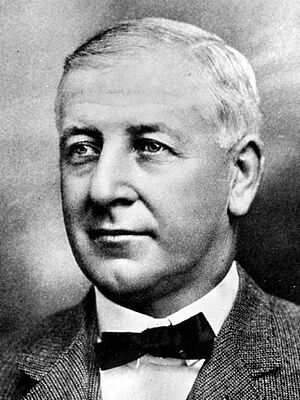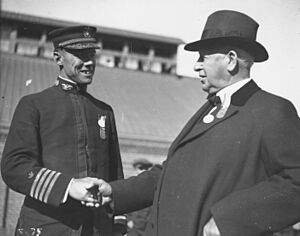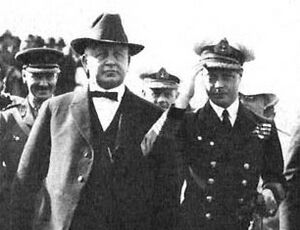William Stephens (American politician) facts for kids
Quick facts for kids
William D. Stephens
|
|
|---|---|
 |
|
| 24th Governor of California | |
| In office March 15, 1917 – January 8, 1923 |
|
| Lieutenant | Arthur H. Breed Sr. C. C. Young |
| Preceded by | Hiram Johnson |
| Succeeded by | Friend Richardson |
| 27th Lieutenant Governor of California | |
| In office July 22, 1916 – March 15, 1917 |
|
| Governor | Hiram Johnson |
| Preceded by | John Morton Eshleman |
| Succeeded by | Arthur H. Breed Sr. |
| Member of the U.S. House of Representatives from California |
|
| In office March 4, 1911 – July 22, 1916 |
|
| Preceded by | James McLachlan |
| Succeeded by | Henry S. Benedict |
| Constituency | 7th district (1911–1913) 10th district (1913–1916) |
| 27th Mayor of Los Angeles | |
| In office March 15, 1909 – March 26, 1909 |
|
| Preceded by | Arthur C. Harper |
| Succeeded by | George Alexander |
| Personal details | |
| Born |
William Dennison Stephens
December 26, 1859 Eaton, Ohio |
| Died | April 25, 1944 (aged 84) Los Angeles, California |
| Political party | Republican Progressive |
| Spouse | Flora E. Rawson |
| Children | Barbara |
| Profession | Engineer, politician |
| Military service | |
| Allegiance | |
| Branch/service | |
| Years of service | 1904–1914 |
| Rank | Major |
| Unit | California Army National Guard |
William Dennison Stephens (born December 26, 1859 – died April 25, 1944) was an important American politician. He served in the U.S. House of Representatives for three terms from 1911 to 1916. Later, he became the 24th Governor of California, serving from 1917 to 1923.
Before becoming governor, Stephens was the 27th Lieutenant Governor of California from 1916 to 1917. He also briefly served as Mayor of Los Angeles in 1909. As governor, Stephens continued many of the important changes started by the previous governor, Hiram Johnson. He was known for being a "Progressive," which meant he supported ideas to make government fairer and help people. He ran for re-election in 1922 but lost to Friend Richardson.
Contents
Early Life and Career
Stephens was born in Eaton, Ohio, on December 26, 1859. He was one of nine children. He wanted to become a lawyer, but his family needed his earnings.
After finishing high school in 1876, Stephens worked as a school teacher for three years. Then, he joined the railroad business as an engineer. From 1880 to 1887, he helped survey railroads in several states. In 1887, his family moved to Los Angeles, California, for his mother's health.
In Los Angeles, Stephens worked as a traveling salesman and later managed a grocery store. In 1891, he married Flora E. Rawson. By 1902, he became a partner in a grocery business, which made him well-known. He became involved in business and local government. He served on the board of the Los Angeles Chamber of Commerce and the Los Angeles Board of Education. He also worked on the Los Angeles Board of Water Commissioners, helping with the Los Angeles Aqueduct project.
In 1906, Stephens served as a major in the California Army National Guard. He helped during the 1906 San Francisco earthquake. In 1909, he became vice president of the American National Bank.
Brief Time as Mayor
On March 15, 1909, Stephens was appointed Mayor of Los Angeles. This happened after the previous mayor, Arthur C. Harper, resigned. Stephens' time as mayor was very short, lasting less than two weeks. George Alexander, who won the election, took over the office soon after.
Joining the U.S. House of Representatives
After his short time as mayor, Stephens entered national politics. In 1910, he was elected to the U.S. House of Representatives as a Republican from California's 7th district. Due to new district maps, he then represented the 10th district and won re-election in 1912 and 1914.
During this time, Stephens became part of the Progressive movement. This movement aimed to improve society and government. He joined the Progressive Party, which was led by former president Theodore Roosevelt and California Governor Hiram Johnson. Stephens was one of the few Progressives elected to the U.S. House. He remained a Progressive until the party ended in 1916, then he rejoined the Republican Party.
Becoming Lieutenant Governor and Governor
In 1916, California's Lieutenant Governor, John Morton Eshleman, passed away. Governor Hiram Johnson chose Stephens to take his place. Stephens resigned from the U.S. House and became lieutenant governor on July 22, 1916.
Stephens' time as lieutenant governor was also short. Governor Johnson was elected to the U.S. Senate in 1916. When Johnson resigned to take his Senate seat on March 15, 1917, Stephens became the 24th Governor of California.
Governorship
Soon after becoming governor, Stephens faced a big challenge: the Preparedness Day Bombing. This was a terrorist attack in San Francisco in 1916. Two people, Thomas Mooney and Warren Billings, were found guilty of the crime. Many people around the world believed they were innocent. President Woodrow Wilson even asked Stephens to look into the case. Stephens changed Mooney's death sentence to life in prison, but he did not pardon him.
Some people who disagreed with Stephens' decision caused trouble. On December 17, 1917, a bomb exploded near the Governor's Mansion in Sacramento. Stephens was not hurt, but the kitchen was damaged. In response to these threats, Stephens supported the California Criminal Syndicalism Act. This law aimed to stop groups that promoted violence against the government. Stephens refused to pardon Thomas Mooney during his time as governor. Mooney was later pardoned by Governor Culbert Olson in 1939.
Continuing Progressive Reforms
Like his predecessor, Hiram Johnson, Stephens was a Progressive. He focused on keeping the good changes that Johnson had already made. He did not try to create many new reforms.
In the 1918 state elections, Stephens ran for governor again as a Republican. He promised to make the Progressive reforms stronger within the state government. He won the election easily, beating his opponent, Theodore A. Bell, by a large margin.
Supporting Veterans and Other Issues
After winning a full four-year term, Stephens became very concerned about soldiers returning from World War I. He believed the state should help them. He supported programs to retrain veterans and help them find jobs. A special veteran assistance program was created because of his efforts. During his time as governor, Stephens also supported the prohibition of alcohol.
Stephens was also worried about immigration from Japan to California. He believed it was a threat to the state and the country. In 1919, he asked the California State Legislature to pass stricter laws to limit Japanese immigrants. Some of his goals were later met by the federal Immigration Act of 1924.
Stephens remained active and visible as governor. In 1920, he was part of the group that welcomed Edward, the Prince of Wales (who later became king), when he visited San Diego. Stephens was also there when his daughter, Barbara, launched the battleship USS California.
While serving as governor, Stephens achieved a lifelong dream: he passed the California Bar exam and became a lawyer. In his final months as governor, he stopped bills that would have weakened state control over utilities. He wanted to protect the Progressive reforms.
In 1922, Stephens sought another term as governor. However, the Republican Party had become more conservative. He lost the Republican primary election to Friend Richardson.
Later Life
After losing his re-election bid, Stephens returned to Los Angeles. He started a law practice. He never held public office again, but he stayed involved in public affairs.
William D. Stephens passed away on April 25, 1944, at the age of 84, from a heart problem. He is buried in Angelus-Rosedale Cemetery in Los Angeles.
Images for kids








